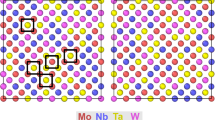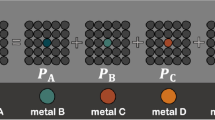Abstract
In computational materials science, a common means for predicting macroscopic (e.g., mechanical) properties of an alloy is to define a model using combinations of descriptors that depend on some material properties (elastic constants, misfit volumes, etc.), representative for the macroscopic behavior. The material properties are usually computed using special quasi-random structures, in tandem with density functional theory (DFT). However, DFT scales cubically with the number of atoms and is thus impractical for a screening over many alloy compositions. Here, we present a novel methodology which combines modeling approaches and machine-learning interatomic potentials. Machine-learning interatomic potentials are orders of magnitude faster than DFT, while achieving similar accuracy, allowing for a predictive and tractable high-throughput screening over the whole alloy space. The proposed methodology is illustrated by predicting the room temperature ductility of the medium-entropy alloy Mo–Nb–Ta.
Graphical abstract








Similar content being viewed by others
Data availability
The implementation of the MTPs is included in the MLIP package which is publicly available for academic use at https://mlip.skoltech.ru/download/ upon registration. Additional scripts, necessary to run our algorithm, as well as the training data, are available from the authors upon reasonable request.
Notes
In principle, the model also depends on other orientations, but it was shown in [26] that the {112} stacking fault plane and the {110} surface plane are the most important ones for Mo–Nb–Ta.
Otherwise the active learning algorithm may erroneously undersample certain compositions not considered in the initial training set.
References
E. George, W. Curtin, C. Tasan, High entropy alloys: a focused review of mechanical properties and deformation mechanisms. Acta Mater. 188, 435–474 (2020)
E. Ma, Unusual dislocation behavior in high-entropy alloys. Scr. Mater. 181, 127–133 (2020)
W.A. Curtin, S.I. Rao, C. Woodward, Progress and challenges in the theory and modeling of complex concentrated alloys. MRS Bull. 47(2), 151–157 (2022)
Yonezawa, Morigaki, K. Coherent potential approximation. Suppl. Prog. Theor. Phys. 53 (1973)
L. Vitos, I.A. Abrikosov, B. Johansson, Anisotropic Lattice Distortions in Random Alloys from First-Principles Theory. Phys. Rev. Lett. 87(15), 156401 (2001)
Y. Ikeda, B. Grabowski, F. Körmann, Ab initio phase stabilities and mechanical properties of multicomponent alloys: a comprehensive review for high entropy alloys and compositionally complex alloys. Mater. Charact. 147, 464–511 (2019)
A. Zunger, S.-H. Wei, L.G. Ferreira, J.E. Bernard, Special quasirandom structures. Phys. Rev. Lett. 65(3), 353–356 (1990)
K. Yang, C. Oses, S. Curtarolo, Modeling off-stoichiometry materials with a high-throughput Ab-Initio approach. Chem. Mater. 28(18), 6484–6492 (2016)
J. Behler, M. Parrinello, Generalized neural-network representation of high-dimensional potential-energy surfaces. Phys. Rev. Lett. 98(14), 146401 (2007)
A.P. Bartók, M.C. Payne, R. Kondor, G. Csányi, Gaussian approximation potentials: the accuracy of quantum mechanics, without the electrons. Phys. Rev. Lett. 104(13), 136403 (2010)
A. Thompson, L. Swiler, C. Trott, S. Foiles, G. Tucker, Spectral neighbor analysis method for automated generation of quantum-accurate interatomic potentials. J. Comput. Phys. 285, 316–330 (2015)
A.V. Shapeev, Moment tensor potentials: a class of systematically improvable interatomic potentials. Multiscale Model. Simul. 14(3), 1153–1173 (2016)
J.S. Smith, O. Isayev, A.E. Roitberg, ANI-1: an extensible neural network potential with DFT accuracy at force field computational cost. Chem. Sci. 8(4), 3192–3203 (2017)
Schütt, K. T., Kindermans, P.-J., Sauceda, H. E., Chmiela, S., Tkatchenko, A., and Müller, K.-R, SchNet: A Continuous-Filter Convolutional Neural Network for Modeling Quantum Interactions, in Proceedings of the 31st International Conference on Neural Information Processing Systems, NIPS’17, pp. 992–1002, Red Hook, NY, USA (Curran Associates Inc. event-place: Long Beach, CA, 2017)
G.P. Pun, R. Batra, R. Ramprasad, Y. Mishin, Physically informed artificial neural networks for atomistic modeling of materials. Nat. Commun. 10(1), 1–10 (2019)
R. Jinnouchi, F. Karsai, G. Kresse, On-the-fly machine learning force field generation: application to melting points. Phys. Rev. B 100(1), 014105 (2019)
C.W. Park, M. Kornbluth, J. Vandermause, C. Wolverton, B. Kozinsky, J.P. Mailoa, Accurate and scalable multi-element graph neural network force field and molecular dynamics with direct force architecture. NPJ Comput. Mater. 7(73), 1–9 (2021)
Y. Lysogorskiy, C. van der Oord, A. Bochkarev, S. Menon, M. Rinaldi, T. Hammerschmidt, M. Mrovec, A. Thompson, G. Csányi, C. Ortner et al., Performant implementation of the atomic cluster expansion (pace) and application to copper and silicon. NPJ Comput. Mater. 7(1), 1–12 (2021)
X.-G. Li, C. Chen, H. Zheng, Y. Zuo, S.P. Ong, Complex strengthening mechanisms in the NbMoTaW multi-principal element alloy. NPJ Comput. Mater. 6(1), 70 (2020)
J. Byggmästar, K. Nordlund, F. Djurabekova, Modeling refractory high-entropy alloys with efficient machine-learned interatomic potentials: defects and segregation. Phys. Rev. B 104(10), 104101 (2021)
S. Yin, Y. Zuo, A. Abu-Odeh, H. Zheng, X.-G. Li, J. Ding, S.P. Ong, M. Asta, R.O. Ritchie, Atomistic simulations of dislocation mobility in refractory high-entropy alloys and the effect of chemical short-range order. Nat. Commun. 12(1), 4873 (2021)
M. Hodapp, A. Shapeev, Machine-learning potentials enable predictive and tractable high-throughput screening of random alloys. Phys. Rev. Mater. 5(11), 113802 (2021)
E.V. Podryabinkin, A.V. Shapeev, Active learning of linearly parametrized interatomic potentials. Comput. Mater. Sci. 140, 171–180 (2017)
K. Gubaev, E.V. Podryabinkin, G.L. Hart, A.V. Shapeev, Accelerating high-throughput searches for new alloys with active learning of interatomic potentials. Comput. Mater. Sci. 156, 148–156 (2019)
X. Li, W. Li, D.L. Irving, L.K. Varga, L. Vitos, S. Schönecker, Ductile and brittle crack-tip response in equimolar refractory high-entropy alloys. Acta Mater. 189, 174–187 (2020)
E. Mak, B. Yin, W. Curtin, A ductility criterion for bcc high entropy alloys. J. Mech. Phys. Solids 152, 104389 (2021)
X.W. Zhou, R.A. Johnson, H.N.G. Wadley, Misfit-energy-increasing dislocations in vapor-deposited CoFe/NiFe multilayers. Phys. Rev. B 69(14), 144113 (2004)
Y.-J. Hu, A. Sundar, S. Ogata, L. Qi, Screening of generalized stacking fault energies, surface energies and intrinsic ductile potency of refractory multicomponent alloys. Acta Mater. 210, 116800 (2021)
Y. Zuo, C. Chen, X. Li, Z. Deng, Y. Chen, J. Behler, G. Csányi, A.V. Shapeev, A.P. Thompson, M.A. Wood et al., Performance and cost assessment of machine learning interatomic potentials. J. Phys. Chem. A 124(4), 731–745 (2020)
G. Kresse, J. Hafner, Ab initio molecular dynamics for liquid metals. Phys. Rev. B 47(1), 558 (1993)
G. Kresse, J. Hafner, Ab initio molecular-dynamics simulation of the liquid-metal-amorphous-semiconductor transition in germanium. Phys. Rev. B 49(20), 14251 (1994)
G. Kresse, J. Furthmüller, Efficiency of ab-initio total energy calculations for metals and semiconductors using a plane-wave basis set. Comput. Mater. Sci. 6(1), 15–50 (1996)
G. Kresse, J. Furthmüller, Efficient iterative schemes for ab initio total-energy calculations using a plane-wave basis set. Phys. Rev. B 54(16), 11169 (1996)
D. Bolef, Elastic constants of single crystals of the bcc transition elements v, nb, and ta. J. Appl. Phys. 32(1), 100–105 (1961)
K.J. Carroll, Elastic constants of niobium from 4.2 to 300 k. J. Appl. Phys. 36(11), 3689–3690 (1965)
F.H. Featherston, J. Neighbours, Elastic constants of tantalum, tungsten, and molybdenum. Phys. Rev. 130(4), 1324 (1963)
L. Koči, Y. Ma, A. Oganov, P. Souvatzis, R. Ahuja, Elasticity of the superconducting metals v, nb, ta, mo, and w at high pressure. Phys. Rev. B 77(21), 214101 (2008)
C. Varvenne, A. Luque, W.G. Nöhring, W.A. Curtin, Average-atom interatomic potential for random alloys. Phys. Rev. B 93(10), 104201 (2016)
C.D. Statham, D.A. Koss, J.W. Christian, The thermally activated deformation of niobium-molybdenum and niobium-rhenium alloy single crystals. Phil. Mag. 26(5), 1089–1103 (1972)
K. Gubaev, E.V. Podryabinkin, A.V. Shapeev, Machine learning of molecular properties: locality and active learning. J. Chem. Phys. 148(24), 241727 (2018)
Z. Liu, J. Shang, First principles calculations of electronic properties and mechanical properties of bcc molybdenum and niobium. Rare Met. 30(S1), 354–358 (2011)
M. de Jong, W. Chen, T. Angsten, A. Jain, R. Notestine, A. Gamst, M. Sluiter, C. Krishna Ande, S. van der Zwaag, J.J. Plata, C. Toher, S. Curtarolo, G. Ceder, K.A. Persson, M. Asta, Charting the complete elastic properties of inorganic crystalline compounds. Sci. Data 2(1), 150009 (2015)
X. Gao, F. Tian, H. Song, Tests on the Accuracy and Scalability of the Full-Potential DFT Method Based on Multiple Scattering Theory. Front. Chem. 8, 12 (2020)
M. Liao, Y. Liu, P. Cui, N. Qu, F. Zhou, D. Yang, T. Han, Z. Lai, J. Zhu, Modeling of alloying effect on elastic properties in BCC Nb–Ti–V–Zr solid solution: From unary to quaternary. Comput. Mater. Sci. 172, 109289 (2020)
C. Varvenne, A. Luque, W.A. Curtin, Theory of strengthening in fcc high entropy alloys. Acta Mater. 118, 164–176 (2016)
C. Hu, J. Luo, Data-driven prediction of grain boundary segregation and disordering in high-entropy alloys in a 5D space. Mater. Horiz. 9(3), 1023–1035 (2022)
M. Hodapp, A. Shapeev, In operando active learning of interatomic interaction during large-scale simulations. Mach. Learn.: Sci. Technol. 1(4), 045005 (2020)
J.R. Rice, Dislocation nucleation from a crack tip: an analysis based on the Peierls concept. J. Mech. Phys. Solids 40(2), 239–271 (1992)
T.T.C. Ting, Anisotropic Elasticity: Theory and Applications (Oxford University Press, Oxford, 1996)
C.T. Sun, Z.-H. Jin, Fracture Mechanics (Academic Press, Waltham, MA, 2012)
P. Andric, W.A. Curtin, Atomistic modeling of fracture. Model. Simul. Mater. Sci. Eng. 27(1), 013001 (2019)
E. Bitzek, P. Koskinen, F. Gähler, M. Moseler, P. Gumbsch, Structural relaxation made simple. Phys. Rev. Lett. 97(17), 170201 (2006)
A. Hjorth Larsen, J. Jørgen Mortensen, J. Blomqvist, I.E. Castelli, R. Christensen, M. Dułak, J. Friis, M.N. Groves, B. Hammer, C. Hargus, E.D. Hermes, P.C. Jennings, P. Bjerre Jensen, J. Kermode, J.R. Kitchin, E. Leonhard Kolsbjerg, J. Kubal, K. Kaasbjerg, S. Lysgaard, J. Bergmann Maronsson, T. Maxson, T. Olsen, L. Pastewka, A. Peterson, C. Rostgaard, J. Schiøtz, O. Schütt, M. Strange, K.S. Thygesen, T. Vegge, L. Vilhelmsen, M. Walter, Z. Zeng, K.W. Jacobsen, The atomic simulation environment-a Python library for working with atoms. J. Phys.: Condens. Matter 29(27), 273002 (2017)
S.A. Goreinov, I.V. Oseledets, D.V. Savostyanov, E.E. Tyrtyshnikov, N.L. Zamarashkin, How to find a good submatrix, in Matrix Methods: Theory, Algorithms And Applications: Dedicated to the Memory of Gene Golub. ed. by V. Olshevsky (World Scientific, Singapore, 2010), pp.247–256
R.W. Smith, G.S. Was, Application of molecular dynamics to the study of hydrogen embrittlement in Ni-Cr-Fe alloys. Phys. Rev. B 40(15), 10322–10336 (1989)
A. Stukowski, Visualization and analysis of atomistic simulation data with OVITO-the Open Visualization Tool. Modell. Simul. Mater. Sci. Eng. 18(1), 015012 (2010)
Acknowledgments
This work was supported by the Russian Science Foundation (Grant Number 18-13-00479). MH would further like to thank W. A. Curtin and B. Yin for helpful discussions during the initial stage of this project. Moreover, the authors would like to thank P. Andric for providing his scripts for computing the Stroh tensors for the K-factors. The figures in this article showing atomistic configurations were created using the visualization software OVITO [56].
Author information
Authors and Affiliations
Corresponding author
Ethics declarations
Conflict of interest
On behalf of all authors, the corresponding author states that there is no conflict of interest.
Additional information
Publisher's Note
Springer Nature remains neutral with regard to jurisdictional claims in published maps and institutional affiliations.
Rights and permissions
Springer Nature or its licensor holds exclusive rights to this article under a publishing agreement with the author(s) or other rightsholder(s); author self-archiving of the accepted manuscript version of this article is solely governed by the terms of such publishing agreement and applicable law.
About this article
Cite this article
Novikov, I., Kovalyova, O., Shapeev, A. et al. AI-accelerated materials informatics method for the discovery of ductile alloys. Journal of Materials Research 37, 3491–3504 (2022). https://doi.org/10.1557/s43578-022-00783-z
Received:
Accepted:
Published:
Issue Date:
DOI: https://doi.org/10.1557/s43578-022-00783-z




